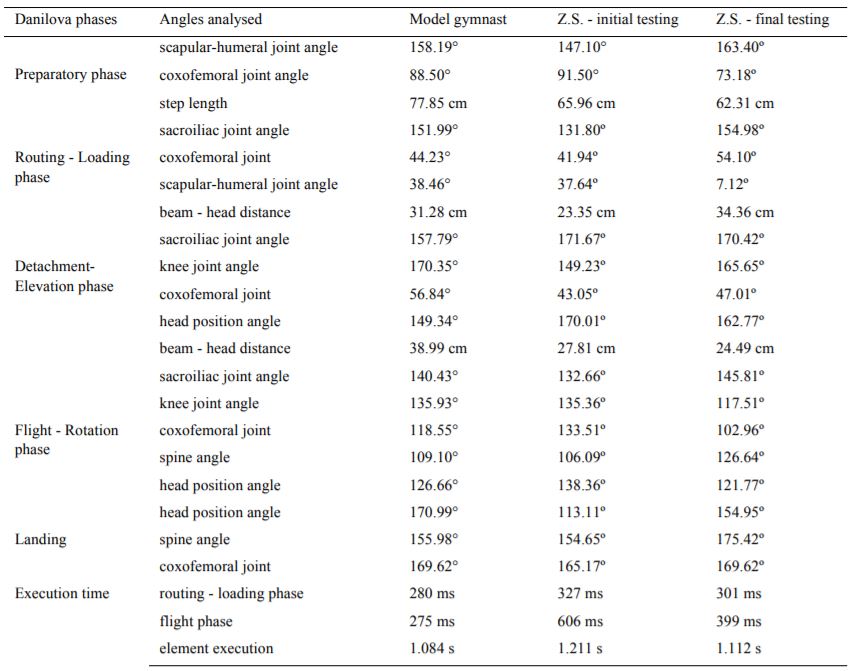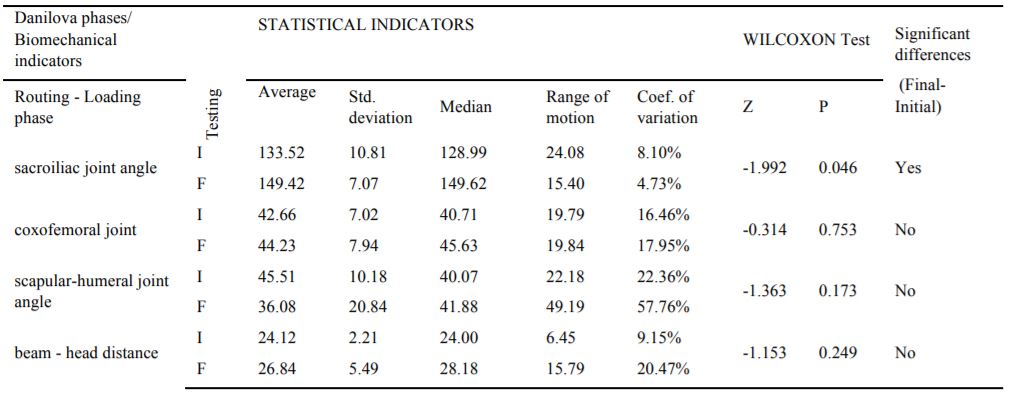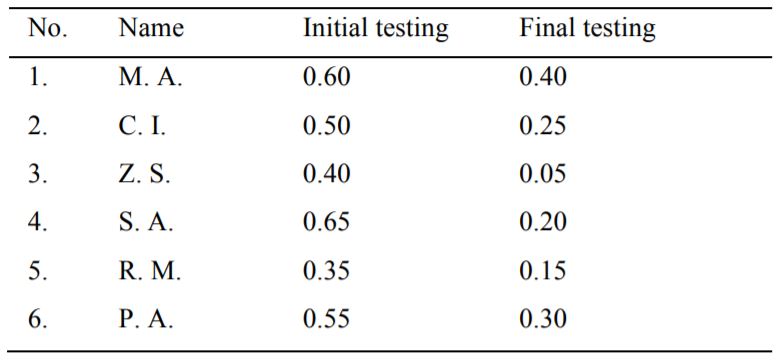Abstract
Acrobatics is the oldest gymnastic activity and the balance beam apparatus, with its structure, is part of it. For a very high level of preparation in women’s balance beam, it is compulsory for them to have morphofunctional integrity of the musculoskeletal system, good joint mobility and muscle elasticity, and very good neuromuscular coordination. The element “Free (aerial) forward walkover, landing on one foot” (Forward Danilova) on balance beam is a dynamic acrobatic element classified in salto group, which is found in most integral exercises to the balance beam and/or floor exercise and can be presented in many forms. The biomechanical reason is that the gymnast can perform the elements in easier conditions. Thorough analysis of the biomechanical data allows outlining more detailed conclusions, such as those related to the kinematic and dynamic errors which lead to and cause other errors. Through these examples, we want to highlight the usefulness of kinematic biomechanical analysis, which covers both analytical interpretation for finding the errors and analytical mode to direct the gymnast, what to do to do it right.
Keywords: Artistic gymnastics, biomechanical analysis, balance beam
Introduction
In artistic gymnastics, balance beam is an event so difficult and spectacular at the same time. This
apparatus is characterized by excellence in physical and mental balance. About the content,
Regulations require that exercises are composed of elements from different structural groups: acrobatic
elements with or without flight phase, performed forward, backward or sideways; elements of
gymnastics as: pirouettes, leaps, jumps, combinations of steps, elements of balance.
Thorough analysis of the biomechanical data allows outlining more detailed conclusions, such as
those related to the kinematic and dynamic errors which lead to and cause other errors.
Materials and methods
Research purpose
Why a biomechanical analysis? According to Gagea (1994: 6), “apart from efficiency, there are
other reasons that may justify the interest in the study of biomechanics. One of these is the need to
expand the biomechanics-related knowledge, and the other one is to increase exercise capacity and
performance in competitions”.
In artistic gymnastics in general, and especially for balance beam apparatus, the learning of any
technical element is carried out based on a biomechanical model that includes the integration of multi-
and cross-disciplinary information from several areas of knowledge and involves completing the
following steps:
•decomposition of movement into component phases; •identification of key-joints and joint movements; •determination of agonist and antagonist muscle groups involved in the specific action in each phase; •identification of specific technical elements addressed (balance, muscle strength or power,
mobility).
The importanceof biomechanical analysis is given by the high performance level that requires the
use of modern training technology in order to capture multiple angles of movement, with all its
kinematics and dynamics, which will double the coach’s “eye” and provide feedback to learning. So,
the current technical level has reached its upper limit, imposing biomechanical analysis in learning.
Research hypothesis
Biomechanical analysis of qualitative research, in parallel with the use of video recording, will
promote the removal of technical mistakes and will lead the gymnast to achieve the model execution.
Subjects
“Take into the consideration that training is performed in an individualized manner”(Teodorescu,
2009: 21). This study is based on a comparative biomechanical analysis between one gymnast who
represents the model execution and six gymnasts who have just learned the studied element on balance
beam (Forward Danilova). Of the six gymnasts, we chose to present the biomechanical analysis for
Z.S., the most representative gymnast, with the best performance.
Description of “Free (aerial) walkover forward,landing on one foot” (Forward Danilova)
“Forward Danilova” is a dynamic acrobatic element classified into salto group, which is found in
most integral exercises to the balance beam and/or floor exercise and can be presented in many forms.
According to gymnast’s skills, the coach can choose the basic variant (the one shown by us) with
landing on one foot, or landing on both feet. In the (2008), the element has the D value,
which means a bonus of 0.40 tenths, or can be combined with other elements and earn a bigger bonus.
Biomechanically, mastery and regulation during the exercise can be made respecting the principle of
the permanent projection of the centre of gravity on the narrow support area of the balance beam.
Rational training for this apparatus requires learning the correct technique since the beginning and
educating the sense of balance using visual analyser and kinaesthetic sensations (Şlemin, 1976: 86).
Biomechanical analysis of model execution and the best gymnast’s execution in the two tests
•Analysis of the preparatory phase
“Step forward must be blocked in order to have a fixed foothold, and lunge will be to achieve the
maximum load and necessary momentum for the next phase. Length of contact with the beam varies
from 0.05 to 0.8 sec., while the centre of gravity moves forward relative to the fulcrum, according to
the model gymnast” (Stroescu, 2014) (Figure 1 (left)).
At the initial testing in the preparatory phase, the best gymnast, Z.S., presents a coxofemoral joint
angle smaller than in the model gymnast, the scapular-humeral joint angle is large, the preparation step
is short, which leads to weaker momentum (Figure 1 (middle)). In the final testing, the trunk remains bent in the
preparatory phase, but other indicators approach to the model values (Figure 1 (right)).

•Analysis of routing - Loading phase
“This phase is that in which there is continuous lowering and arm lowering, torso forward and
down, while balancing in speed the oscillating rear leg. Since angular momentum is the product of the
moment of inertia and angular velocity (Donskoi, 1959: 56), the gymnast can increase angular velocity
when the oscillating body and leg reach the peak and achieve this tense “arc”, which will trigger
vertical momentum and detachment (Stroescu, 2014) (Figure 2 (left)).
In this initial testing phase, the gymnast presents low mobility in the sacroiliac joint and incorrect
head positioning (chin to chest) (Figure 2 (middle)). In the final testing, all values of joint angles are improved
(Figure 2 (right)).

•Analysis of detachment - Elevation
“This impetus triggered by the past actions of forces engaged is the culmination of achieving
vertical phase separation. Detachment effort is made by the triple chain leg extension. Contraction of
the muscle groups for overcoming mechanical work must coincide in time, contrary to the thigh and
lower leg lever formats which constitute a deterrent (Figure 3 (left)). Due to the small step of preparation,
elevation is not sufficient, and that compensatory movement appears as a bent-leg landing” (Stroescu,
2014) (Figure 3 (middle)). The final testing of biomechanical indicators is close to the model values, except that
further head positioning is poor (Figure 3 (right)).

•Analysis of flight - Rotation
“Movement biomechanics is always coordinated, which implies restrictions in trajectory, speed time
and sometimes accelerations. While rotation occurs, swing foot landing prepares thus to form another
tense “arc”, which will help to further raise the trunk that, this time, remains in extension. Iliac and
abdominal muscles play an important role in this movement phase, as they provide the physical support
required to maintain the final position (Figure 4 (left)).
During the flight phase, in the initial testing, the coxofemoral joint angle is too small, the gymnast
bringing the trunk towards the foot in place of the spine extension, and the leg which has triggered the
separation is not controlled (Figure 4 (middle)). In the final testing, biomechanical indicator values are close to
the model” (Stroescu, 2014) (Figure 4 (right)).

•Analysis of landing phase
According to the previous phase, the foot is ready for landing, and this is achieved by successive
contacts of foot with cushions, while raising the trunk until it reaches the standing away position in the
sagittal plane. Beam contact is gradually made with metatarsals, leaving the entire sole weight (Figure 5 (left)). “These movements engage in effort the entire body, especially bone-ligament and muscle
systems” (Grigore, 1998: 43).
“As regards landing in the initial testing (Figure 5 (middle)), wrong arm positioning (too close to the trunk)
and lack of extension in the spine lead to a landing with major mistakes (additional movements of
arms, incorrect positioning of feet and additional step for balancing). In the final testing, landing is
done properly, without penalty” (Stroescu, 2014) (Figure 5 (right)).

Results
In Figure 6, we presented the angle values obtained from the biomechanical analysis of the model
gymnast and the gymnast Z.S., in the initial and final testing.

To highlight the effectiveness of biomechanical analysis, we used the Wilcoxon Test for assessing the statistically significant differences recorded between the two tests. For each part of the element, there are differences between the two tests, but they are not statistically significant, since the p-values of threshold significance provided by the Wilcoxon Test for each element are higher than 0.05. In the following lines, we will present only the element phases for which statistically significant differences have been found (Figure 7).

For each element of the routing - loading phase, there are differences between the results of the two
tested gymnasts, but they are not statistically significant. An exception is the sacroiliac joint angle, for
which the value of materiality is p< 0.05. P-values provided by the Wilcoxon Test for other elements of
this phase are greater than 0.05. For the first two joints analysed (sacroiliac joint angle and
coxofemoral joint angle), averages increased in the final testing, while for the other two joints
(scapular-humeral joint angle and beam - head distance), averages decreased. The data dispersion is
relatively homogeneous.
As to the execution time phase, average values fell in the final testing. Differences between the
gymnasts’ results in the two tests, for each element of this phase, are statistically significant,
materiality values provided by the Wilcoxon Test showing that p is less than 0.05 (Table 1).
Significant reduction of the three periods increased the execution speed on beam. At this point, the
data dispersion for each component has a homogeneous structure. The results of gymnasts in
performing the “Forward Danilova” element are presented in Figure 8.

Conclusions
Thorough analysis of the biomechanical data shows that the gymnasts’ results have improved in the
stage of learning and acquiring the Danilova element. Exemplifying, we can see that the worst penalty
executions took 0.40 tenths, while the best executions received only 0.05 tenths. Specifically in our
case, gymnasts who were successful in two tests have managed to improve their performance, being
very close to the model gymnast’s performance.
References
Code of Points. (2008). Retrieved from http://www.codeofpoints.com/
Donskoi, D. (1959). Biomecanica exerciţiilor fizice. Timişoara: Editura Tineretului.
Gagea, A. (1994). Biomecanică în sport. Bucureşti: Editis.
Grigore, V. (1998). Gimnastica de performanţă. Bucureşti: Inedit.
Stroescu, S. (2014). Valorificarea factorilor interni ai capacităţii de performanţă prin algoritmizarea învăţării unor elemente tehnice cu rotație în ax transversal din Gimnastica Artistică feminină (pp. 232-233; 244-254). (Teză de doctorat). UNEFS, Bucureşti.
Şlemin, A.M. (1976). Pregătirea tinerilor gimnaşti. Bucureşti: Sport-Turism.
Teodorescu, S. (2009). Antrenament şi competiţie.Buzău: Alpha MDN.
Copyright information

This work is licensed under a Creative Commons Attribution-NonCommercial-NoDerivatives 4.0 International License.
About this article
Publication Date
10 June 2016
Article Doi
eBook ISBN
978-1-80296-010-5
Publisher
Future Academy
Volume
11
Print ISBN (optional)
-
Edition Number
1st Edition
Pages
1-509
Subjects
Sports, sport science, physical education
Cite this article as:
Stroescu, S. A. (2016). Biomechanical Analysis of “Free (Aerial) Forward Walkover, Landing on One Foot”. In V. Grigore, M. Stanescu, & M. Paunescu (Eds.), Physical Education, Sport and Kinetotherapy - ICPESK 2015, vol 11. European Proceedings of Social and Behavioural Sciences (pp. 371-378). Future Academy. https://doi.org/10.15405/epsbs.2016.06.51

